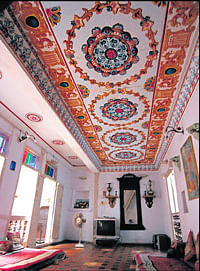
The citizens of Ahmedabad celebrated Diwali by distributing sweets and meeting up with relatives and friends to exchange Diwali greetings. The young burst crackers with abandon. Many families lit various types of diyas in their homes to mark the festival of lights. Businesses started a new financial year by opening fresh account books. But for some families, it was an occasion to renovate and upkeep their heritage buildings in this city, nearly 12,000 of them as per the count taken by the Heritage Department of the Ahmedabad Municipal Corporation.
These are heritage houses of Ahmedabad tucked deep inside the walled city
areas, known as Pols. The stately residences are no less than any classic heritage monuments. Old they may be, but their beauty have dazzled the best architectural minds as far as France.
The families use Diwali as an opportunity to revive the age-old traditions and culture by doing up the buildings. They take up the work after getting the necessary approvals from the Heritage Department, whose officers supervise and guide the restoration work. For those residing in these heritage houses it is about traditional rangoli which has a story to tell and at this time of the year it is also about the restoration of century-old utensils to be brought out for display.
“The house was on the verge of collapse and we realised that if the last pieces of these beauty also disappear it will be difficult for our younger generation to restore it as they would not have any idea about the original structure,” says 81-year old Mr Arvind Mehta residing in the 1871 heritage house in Khadia area. Mehta, who retired from the Ahmedabad Electricity Corporation ( now called Torrent Power), lives with his son and grandchildren in the House. For him, such occasions are a time to familiarise the younger generation with the old traditions and culture. Their house in this Pol was among those selected as part of the heritage project initiated by governmental agencies in partnership with NGOs.
“It is not possible to remove these century-old utensils and other traditional items like the spread on the swing for all occasions. At this time of the year, the decorations are pulled out of the storage with the help of the children and they help us in recalling some of the old memories,” says Mehta. The authorities put the number of heritage buildings in the City at around 12,000. The owners need to take permission from the Heritage Department of the Ahmedabad Municipal Corporation for undertaking repairs or changes. The officials from the department supervise and guide during the restoration work, if taken up in the identified buildings.
“It is during the restoration that we were able to do up the ceiling which had some Italian work and this Diwali we plan to do up that part of the ceiling as well so that this area of the house to gets its old original look,” said Mehta. The Mehtas reside with three generations. The third generation, comprising 21-year old female twins and their brother, older by a year, share the elders’ enthusiasm for celebrating the festivities in their heritage home.

“Every year, the rangoli that is created in the otla (courtyard) has a story to tell,” said Suchi Mehta, the daughter-in-law of the household. Last year the rangoli was a theme from the Ramayana.
“It is the children who take interest in the decorative work,” said Suchi Mehta. The elders keep reiterating that more than bursting crackers and lighting up the house erratically it is beauty with a message of decoration and restoration.
Abhay Mangaldas of the Ahmedabad for World Heritage City, who has been working for conservation of heritage, says that it is not just restoration work but the realisation that restoration was a necessity that makes the difference. “Paying attention to minute details like proper lighting and using the right kind of utensils which have some significance with the festivities are also important for the younger generation to know,” said Abhay Mangaldas.
Bina Brahmbhatt, who also lives in a heritage house, points out that the Diwali is the occasion when the heritage homes get their original beauty and looks. “It is this time of the year that the children are initiated into learning alphabets. They are also taught about the importance of upkeep and restoration of the buildings. The children learn about steps to be taken to ensure the colours do not fade. They are explained the significance of colours and pictures on the walls and ceilings so that they are not defaced,” said Brahmbhatt. So while the city celebrates with a display on a variety of crackers, the residents of heritage homes find time to pass down traditions and celebrate as well.